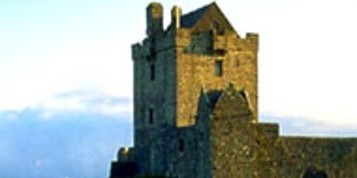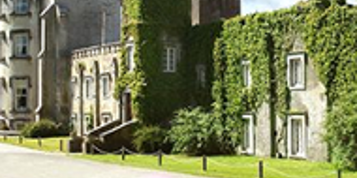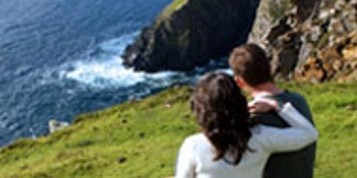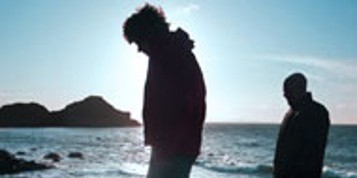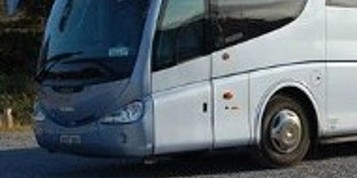2014 marks the millennium anniversary of the most savage battle in the entire history of Ireland and also the death of the greatest high king of Ireland, Brian Boru. Discovering Ireland are pleased to be able to offer a superb range of high quality tours of Ireland which commemorate these events, not only in 2014 but beyond.
These tours give you the opportunity to follow in the footsteps of the great high kings and warriors of ancient Ireland. If you are descendant from one of the great clans of Ireland including the O’Brien’s, MacNamara, O’Grady’s you will be able to discover your heritage and the role that your very own ancestors played in the events leading up to and during the Battle of Clontarf . The fact is that nearly every clan in Ireland was involved in this battle.
Visit medieval fortresses, museums and memorials that will help you to feel connected to this ancient land. What is more if there are areas of particular significance to your family or clan we can personalise the tour to suit your precise needs. While you travel, enjoy the impressive scenery and intriguing history that Ireland has to offer.
While the 1000th anniversary of this pivotal battle will take place in April 2014, this wide-ranging series of chauffeured and self-guided tours of Ireland will be available for all those who wish to travel to Ireland in 2013, 2014 and beyond.
Brian Boru C.941 - 1014
Bryan Boru or Brian Boru as he was more commonly known was born in Killaloe in the year 941 or thereabouts. The son of Cennétig mac Lorcain and Bé Binn inion Urchadh, his family belonged to the Dal gCais Clan based in the province of Munster. Throughout his entire life Brian Boru struggled with the Vikings. After his brother Mahon was killed by Viking forces in the year 978, Bryan became the head of the Dal gCais and King of Munster.
As the Dalcassians and Brian Boru (Bryan Boru) were growing in power in the South of Ireland, his rival Mael Sechnaill mac Domnaill, High King of Ireland was gaining power in the North. In the year 1002, Mael Sechnaill succumbed to the powerful Brian Boru, thus making Brian Boru High King of Ireland.
For a short time after his initial reign as High King of Ireland, Brian Boru’s enemies subjected to his rule, but this was to be short lived. The King of Leinster Mael Morda allied himself with Sigtrygg Silkbeard the Norse King of Dublin and grew an army to fight against Bryan Boru and his following. Both sides collided on Good Friday morning in Clontarf in the year 1014. The Battle was fierce and savage with more than 10,000 men killed on that day. Brian Boru and his allies won the battle but Brian paid greatly with his life.
Booking
Complete our short enquiry for here: Booking form
or call us:
1800 963 9260 toll free from USA/Canada
+353 28 22100 elsewhere
- Killarney, County Kerry for 2 nights
- Killaloe, County Clare for 2 nights
- Dublin for 2 nights
- Economy Manual Car, e.g. 5 Door Fiat Punto. Upgrade rates are available upon request.
Included with your car:
All compulsory insurances - Collision Damage Waiver (with an excess/deductible), theft protection insurance, location fee of €30, Road fund tax, sales tax at 13.5%, unlimited free mileage, third party liability insurance, 24 hour peace of mind break down cover
Day 1 – Shannon to Killarney
After your arrival into Shannon, you will be heading to the very popular town of Killarney in County Kerry via the pretty village of Adare. In Adare, visit the heritage centre and take a tour of the 13th century Norman castle in the village. Onwards to Killarney. With its three famous lakes and majestic mountain ranges, Killarney has been the inspiration of poets and painters over many centuries. The Killarney National Park is internationally renowned both for its scenic beauty and scientific interest. There are many walks and trails around Killarney including a 2-hour tourist trail around the town itself. You will also have a chance to visit Ross Castle, the Gap of Dunloe with the Black Valley or simply take a stroll through the streets of this quaint town to enjoy the great pubs and enjoy the traditional Irish music on offer.
Day 2 – The Ring of Kerry
You have a number of touring options today. Chief amongst these is the Ring of Kerry driving tour. The Ring of Kerry is a journey through some of the country’s most outstanding scenery around the Iveragh Peninsula. Stunning mountain and coastal scenery combined with colourful towns and villages will make this one of the highlights of your tour. For those who wish to take a break from driving we can arrange a bus tour through this route. Following the peninsula drive, you then arrive at Muckross House. Muckross House is a magnificent Victorian mansion completed in 1843 for Henry Arthur Herbert. The location of the House is spectacular, close to the eastern shore of Muckross Lake and set beneath the impressive backdrop of Torc and Mangerton Mountains. As an alternative to the Ring of Kerry tour you may prefer to take a wonderful tour by pony and trap that takes you through the Black Valley in the Gap of Dunloe. After a snack at Lord Brandon’s Cottage, you will return to Killarney by boat via the beautiful lakes of Killarney.
Day 3 – Killarney to Killaloe
Today’s journey takes you to Killaloe in County Clare via Adare village in County Limerick. Adare is regarded by many a seasoned traveller as Ireland’s prettiest village with its charming thatched cottages, manicured public park and ancient church. From Adare continue along the N20 towards Limerick City of ‘Angela’s Ashes’ fame and home to King Johns Castle. King Johns Castle is situated in the heart of the medieval district known as “King’s Island” and sits proudly on the River Shannon . It was originally built by the Vikings, the remains of which were founded during the construction of visitors centre at the site. In 943 the chief of the local Dalcassian clan joined forces with the Ceallachán, King of Munster and the Vikings were overpowered and reduced to the level of a minor clan. The arrival of the Anglo- Normans in 1172 changed everything. Domhnall Mór Ó Briain burned Limerick city to the ground in a bid to keep it from the hands of the new invaders. After he died in 1194 the Anglo- Normans finally captured the area in 1195 under John, Lord of Ireland. A castle was then ordered to be built and named in his honour. Take a short walk to St. Mary’s Cathedral which founded by King Donal Mor O’Brien, the last King of Munster for the Cistercians circa 1180.
On to beautiful village of Killaloe, birthplace of Brian Boru (Bryan Boru), where you will trace the footsteps of Brian Ború growing up and becoming King of Munster through Battle re-enactments by local groups as well as local theatres. Visit The Brian Ború Heritage Centre in Killaloe where there is an imaginative exhibition that charts the history of Killaloe, Brian Ború and the towns Celtic and nautical significance.
Day 4 – In Killaloe
From Killaloe, travel to the spectacular Cliffs of Moher on the west coast of Clare and the Burren region close by. The Cliffs lay claim to one of the most astonishing views in Ireland, on a clear day the Aran Islands are visible in Galway Bay as well as the valleys and hills of the Connemara region. The Cliffs of Moher rise from Hag's Head to the south and reach their highest point (214 meters) just north of O’Brien’s Tower. The tower was built on the cliffs in 1835 by local landlord Sir Cornellius O'Brien a descendant of Brian Boru, Kings of Thomond. He built it as an observation tower for the hundreds of Victorian tourists that frequented the cliffs at the time. Folklore holds that Sir Cornellius O'Brien was a man ahead of his time, believing that the development of tourism would benefit the local economy and bring people out of poverty. He died in 1857 and his remains lie in the O'Brien vault in the graveyard adjoining St Brigid’s Well. There are over seventy megalithic tombs in The Burren region of County Clare, the most well known and most easily accessible being the Poulnabrone Dolmen Tomb. Radiocarbon dating suggests that the burials in this tomb took place 3800 and 3200 BC. As you return to Killaloe, you come to Bunratty castle. Bunratty Castle is where the O’Brien’s ruled as Earls of Thomond from the early 16th century. They ruled the territory of North Munster and lived in great splendour .The castle was surrounded by beautiful gardens and it was reputed to have a herd of 3000 deer. Under Henry VIII's 'surrender and re-grant' scheme, the O'Brien's were granted the title 'Earls of Thomond' and they agreed to profess loyalty to the King of England. The reign of the O’Brien’s came to an end with the arrival of the Cromwellian troops and the castle and its grounds were surrendered. The O’Brien’s never returned to Bunratty but later they built a beautiful residence at Dromoland Castle, now a five star castle hotel. Today Bunratty Castle and Folk Park is a must see for visitors. Within the grounds of the castle, the Folk Park vividly depicts 19th century life. It has a restored village street complete with pub, post office school and doctors house. Adjacent to the castle is Durty Nellys, one of Ireland’s most famous pubs, perfect for a thirst quenching pint of the black stuff!
Day 5 – Killaloe to Dublin via Cashel
Today’s journey to Dublin via Cashel in County Tipperary will take in the region of 3 hours driving time. First stop is Cahir Castle, one of the largest castles in Ireland. It is sited on an island on the River Suir and was built in 1142 by Conor O’Brien, Prince of Thomond. Once an important stronghold of the powerful Butler family, it was surrendered in 1647 to Murrogh O’Brien the 6th Baron Inchiquin (a descendant of the present Chief of the O’Briens, Conor O’Brien). Today it retains its impressive keep, tower and much of its original defensive structure. It is one of Ireland’s largest and best-preserved castles. From here travel the short distance to The Rock of Cashel . Set on a rocky plateau that rises 300 feet, it is visible for many miles and it is immediately apparent why the location was ideal for a fort or strong hold. For centuries the Rock of Cashel was the seat of the Kings of Munster, the most famous being Brian Ború who was to become High King of Ireland. In the 5th Century, King Aengus was baptised by Saint Patrick on the rock. Understandably the Rock of Cashel is today one of the most spectacular and iconic tourist attractions in Ireland. On to Dublin. 2014 marks the 1000th anniversary of the Battle of Clontarf which claimed the lives of over 10,000 people including the 175th High King of Ireland, Brian Ború. The battle took place on 23 April 1014 between the forces of Brian Boru and the forces led by the King of Leinster, Máel Mórda mac Murchada: composed mainly of his own men, Viking mercenaries from Dublin and the Orkney Islands led by his cousin Sigtrygg, as well as the one rebellious king from the province of Ulster. It ended in a rout of the Máel Mórda's forces, along with the death of Brian. Take time out to visit the area where this historic battle took place. 200 years ago Clontarf was a rather isolated coastal village and access to it from the city, other than the sea, would have been along what is now Summerhill and the Malahide Road .The battle was fought along the banks of The River Tolka from Glasnevin to Ballbough. We can only imagine what a sight it must have been to see 2,000 Vikings land their longboats close to the seafront in Clontarf.
Day 6 – While in Dublin
Continue your sightseeing in Dublin today visiting the many historical and modern attractions that this cosmopolitan city has to offer. Other attractions include Christchurch Cathedral which was founded in the year 1030 by Sitric, King of the Dublin Norsemen, the James Joyce Centre & the Dublin Writers Museum. Of course, you may wish to take time out to shop in Grafton Street or any one of a number of narrow and quaint streets that the café strewn city centre has to offer. The Dublin Hop On Hop Off Bus is an excellent way of visiting many of Dublin’s most historic locations including the Guinness Storehouse, Kilmainham Gaol and Trinity College and the Book of Kells. This evening, why not spend some time in the Temple Bar area. This small area boasts a dazzling choice of restaurants, cafes, bars and shops to suit all tastes and pockets, all within easy walking distance of Temple Bar's many cultural centres and galleries. Its narrow cobbled streets are pedestrianised and are ideally suited to a leisurely stroll through the quarter. There is also the opportunity to experience an evening’s entertainment at any one of a number of excellent traditional Irish shows.

